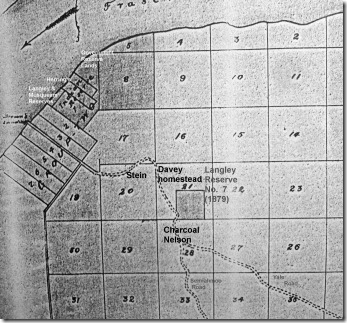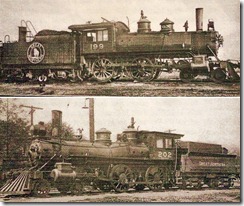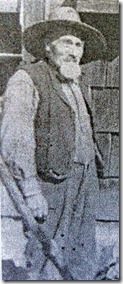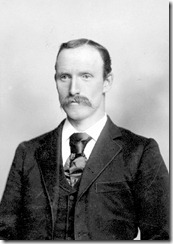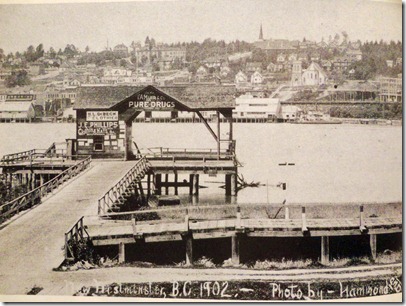The ferry “Surrey”– River front fire engine
Trial by fire 1.
Ackerman says "Go."
Toward the middle of March 1891, the new Fraser River ferry Surrey was still in the hands of contractors, undergoing finishing work and testing.
The Surrey was to face a stiffer test one late one night when a fire was spotted on the south shore, near to Punch’s Hotel at Brownsville–a test of protocol as much as ability.
The Surrey could be depended to respond. After some debate as to cost, the vessel had been sensibly equipped with a turret nozzle and hydrants operated by her on-board steam pump. She could draw water from the river and supply it with force, and in the words of an admiring commentator, she “was practically a river front fire engine.”
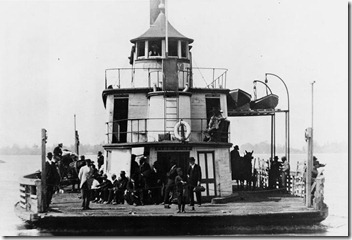 |
|
| Steamer Surrey - Fraser River ferry and fire-boat |
Firemen scrambled down to the ferry dock and it was expected the Surrey would go over directly. However, Captain James Card was operating the ferry for the contractors Reid and Currie and could not leave without a say-so. In the meantime she readied her fire apparatus while agitated lookers-on urged them to get moving.
"While an animated discussion was going on a man approached the Captain and informed him there was a large quantity of dynamite stored at Brownsville landing, and this information confirmed him in his decision not to leave on his own responsibility"
After many anxious minutes Capt Card "went up town" and called Mr Reid, who gave his sanction, providing the Captain took great caution.
Returning to his vessel the Captain met Alderman WJ Walker and requested permission from the City, however,
"Ald. Walker declined taking any such responsibility on his shoulders, as the fire was not within the city limits. Capt Card next asked Chief Ackerman, and the Chief said ‘go,’ and a minute later the ‘Surrey’ was steaming for Brownsville. On arriving there the Chief got his men instantly to work, and in a few minutes the fire was completely extinguished."
This was surely the first suppression of fire by a fire-boat in British Columbia and likely the first action by an official fire-brigade in Surrey.
Never able to resist the cinematic effects of a blaze and its effect on a crowd, and giving scant attention to the potential for injury or loss, the newspaper reported—
"From Westminster the fire look very grand, and the foggy condition of the atmosphere added considerably to the weirdness. From the upper portion of the city the best view was obtained, and hundreds of people remained out in the pelting rain for some time viewing the flames as they flashed up into the night and fitfully illuminated the picturesque surroundings."
On March 3rd , 1891, it was reported to the Brownsville Constable John Beaton that Michael Davey, the rancher at the top of the Yale Road hill, adjacent the Indian Reserve, was dead after a bout of drinking with his neighbours Robert Wilkinson and John Devine.
Michael Davey had taken up residence on the Brownsville hillside in 1885, where he applied for Section 21. His application to complete a Crown Grant in 1890 was supported by affidavits from James Wilson of Section 25, Tsp 38, and John W Stein, who stated he had known Davey since arriving in Surrey, at Mud Bay, in early 1884.
Davey’s house had burnt down in his first year on the hill, and he had rebuilt a small house, 12 x 18 feet, with lean-to, where he lived alone. He had a garden of 3 acres with 18 fruit trees, but no stock. He described his property as:
"all dead fir timber land, having had a number of summer fires running through it, so that the timber is worthless, except perhaps for fuel in part, besides several dead cedars here or there suitable for rails, etc."
An inquest into the death of Davey appeared to be a formality, but something of the circumstances aroused the suspicions of the astute Governor of the Provincial Gaol, William Moresby, who decided to investigate further.
Eschewing his training as a lawyer, English born William Moresby had gone to the Cariboo at an early age and in 1868 entered the Police. He was assistant jailer at the New Westminster Gaol in 1878 and later Governor.
Moresby found evidence of strychnine poisoning and a routine inquest turned into a murder investigation. Witnesses called included John Stein, Justice of the Peace, who owned the prosperous farm at the base of Brownsville Hill.
Moresby determined that the only person known to have purchased strychnine in the past few months was Mrs Stein. She kept the poison in a window near the road, where it might easily be seen by passers by, but no positive link with the death was established.
Wilkinson and Devine were taken to the Provincial Gaol where they would be held without bail for nine months and finally released.
Michael Davey died intestate. His property was subdivided and in July it was put up for sale by the county administrator. The property, comprising the block partially occupied by the present Royal Kwantlen Park, was advertised as—
"situate within a short distance of the south bank of the Fraser River, opposite New Westminster, [and] commands a beautiful view of that city, and is near the towns of Liverpool and South Westminster. Through this property the Yale Road passes."
First runs and auspicious openings
New Hotels at South Westminster
In the first week of 1891, railway builder Nelson Bennett arrived in Liverpool from Fairhaven, having pumped a handcar 18 miles after a train derailment. The following week one of the engines sank into a bog between Port Kells and the Serpentine River. Work continued, and a week later, the first through train arrived from Fairhaven.
With the ferry terminal complete and trains running the length of the track to Fairhaven, plans were announced for three new hotels at South Westminster.
"John George, of Surrey, has made arrangements for the erection of a large hotel at South Westminster, near the ferry landing. The building will be 40 x 80 feet, and two and a half stories high. The hotel will be fitted in first class style throughout and commodious stables and out houses will also be erected in connection with it."
John and Katie George formerly ran a general store and Post Office at Clayton Hill on the Yale Road, afterwards taken over by Charles Cameron.
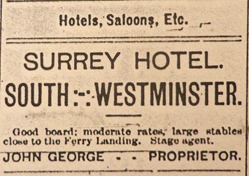 |
|
| Surrey Hotel — John George Proprietor |
Robert Crossman built a hotel, stables, etc with the main building 26 x 62 feet and two stories high, white with red trimming.
And a third was announced.
"Mr Phil Smith, the popular host of the Occidental Hotel, is about to build a new hotel at South Westminster. The building will be 62 feet long, 28 feet wide, and two stories high. Mr Smith intends to call it the Surrey Hotel, and has already applied for a licence."
This hotel, in the first block of Lot 6, would contain 30 rooms including a restaurant and billiard room.
The longstanding use of the south shore as a target again was evidenced.
"Three cannon balls were found at South Westminster last week while workmen were digging the foundation for the new hotel. They were probably sent there during one of the target practices of the artillery."
Inaugural run of the ferry Surrey
On February 9, 1891 the newly finished ferry Surrey, having had installed her boiler, engines, and fittings, was given her first official trial under Captain Michael Terhune, taking a party of dignitaries–city officials and the Fire Chief Thomas Ackerman, and contractors on the construction, including Reid and Currie for machinery and D Henderson for the cabin woodwork— from the CPR wharf up to the Brunette Shipyard, where she made her first landing under power. John Reid handed out sufficient Havanna cigars for the assembly and then the Surrey put out into the river to Liverpool and after "coasting down past old Brownsville," she "returned to her permanent wharf on the north side." The run was a success but there was still work to be done before putting her into regular service.
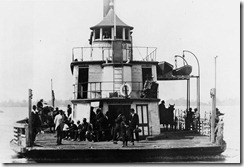 |
|
| Ferry steamer Surrey launched 1891 |
Valentine’s Day fete – Meeting of the rails
February 14, 1891 was the date chosen for the official opening of the rail line to Fairhaven. A fresh layer of snow lay on the ground as Engine 202 did the honors.
[Pulling] "gaily out of Liverpool Station. . .the train slowed down after proceeding a few hundred yards and finally stopped" alongside a platform near which stood a tall mast, "from which proudly floated the meteor flag of old England."
TJ Trapp, a director of the railway company, and a principal in the "Liverpool Land and Improvement Company," presented to Mrs Nelson, the wife of the Lieutenant-Governor of British Columbia, a deed to a corner lot in the new city, and she in turn, christened it "Liverpool."
The train proceeded to the boundary line, where a ceremonial meeting of trains joined the two lines, the Fairhaven and Southern Railroad and the New Westminster Southern Railway, together. Much banqueting ensued, at Blaine, at Fairhaven, and at New Westminster.
| The Fairhaven and Southern Railroad engine met No 202 of the New Westminster Southern Railway at the international boundary at Blaine. | 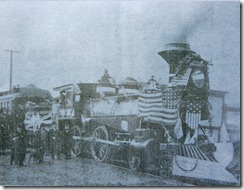 |
| FSR locomotive, decorated for the opening |
Despite the fanfare, it would be a long time before the railway was put in working order. Work continued on ballasting the track. The Columbian reported:
"There are about 200 men employed on the Southern Railway, and about 70 at Liverpool. They consume about 10 quarters of beef daily."
Accounts of the grand opening were reported in major newspapers through the northwest. Railways were big news everywhere, and the connections they forged were a benefit to every city with a train station. But travellers venturing into the northwest corner of Washington State met with disappointment. A Seattle correspondent reported:
"The railway service north from Seattle to New Westminster is not yet organized . . . The construction companies have not yet turned these lines over to the railroad company. . .
The only mode of communication between the two countries is by stage, the driver of which evidently dreads to start out on a trip. It is stated that the roads are in an almost impassable condition and that it takes fully six hours to make the run of 20 miles."
Brownsville Post Office
Brownsville Post Office opened in February 1891. The first Postmaster was John Beaton, who opened a store there. Beaton would double as a Constable in service of the township of Surrey.
Bon Accord siding
The Bon Accord Cannery two miles up from Liverpool was to be the first industry in Surrey to take advantage of the railway, announcing that it would construct a spur-line to its buildings.
"This will enable the company to load their goods ready for direct shipment, and save the cost of several handlings."
The cannery had branched out from its origins as a salmon packer under the management of Haigh & Sons. The new owner Mr Daniel J Munn found success with plums and other fruit grown locally in abundance, now canned with colorful labels depicting fruit, the setting sun, and the legend "Occident Brand."
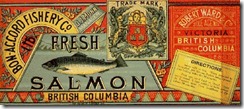 |
|
| Bon Accord Fishery Co Fresh Salmon |
Three full stops on the line
Liverpool BC
Anticipating the completion of the New Westminster Southern Railway, speculators had been busy buying up land at the railhead, to the east of Brownsville at Herring’s Point. This was to be the site of the railway wharf and a trans-shipment station for passengers and rail cars until a bridge could be built.
The length of the railway wharf was to be 740 feet, and work was commenced in April 1890 under the direction of the contractor EM Bradshaw & Co. By June the wharf was complete and the Rand Bros Real Estate Co was trumpeting the sale of a town lots at the new townsite of Liverpool— "Fraser River Terminus of the New Westminster Southern Railway."
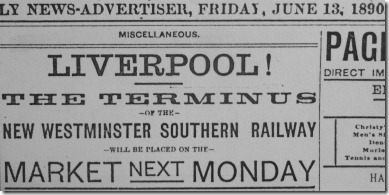 |
| Liverpool – The Terminus of the New Westminster Southern Railway |
The rails were still at sea, with no sign of the imminent arrival of the ships Cordelia and Astoria.
Taking note of the new townsite, the BC Directory would note:
"At present Liverpool consists of a wharf and a prospect."
Rails arrive – Liverpool England to Liverpool BC
The arrival of the Cordelia from England was a tremendous event for the city of New Westminster. It was reported that
"Eager watchers lined the wharves yesterday afternoon on the watch for the long expected ship with the New Westminster Southern Railway rails."
It was 11:30 at night before she put in to the dock at Liverpool, July 25, 1890
She was an iron-clad barque of 598 tons, bearing a cargo of 1500 tons of steel rails. A sailing vessel, with four masts, and a crew of 14, she had a rough passage around the Cape. She had been 140 days from Liverpool England to Liverpool BC.
On August 1st a party of railway men including JJ Donovan, Chief Engineer, George P. Janes, Engineer of Construction, James Leamy, construction contractor and Benjamin Douglas, a Director of the NWSR, went over to Liverpool to view progress. Donovan and Leamy set out to walk the railbed to Fairhaven to inspect the work before the ties were laid.
A little ferry, the Nellie Taylor, commenced regular trips between the city and the Liverpool wharf in August.
Arrival of the locomotives
In the last week of August two locomotives arrived in New Westminster from Winnipeg. Locomotive 199 was taken down by the Purdy to Fairhaven to work from the south.
"Twelve flat cars, one caboose, and locomotive 202 of the Great Northern have been taken over to Liverpool by the steamer Constance. The locomotive will be put to work immediately drawing steel to the end of the track, and when this is completed it will be used on the ballasting train."
It was noted in the press that locomotive 202 was "small compared with the CPR engines."
Nelson Bennett now had completed his opulent Fairhaven Hotel, and an excursion party from New Westminster went down by the steamer Purdy to Bellingham Bay to attend the grand opening. Bennett had bought the townsite of Fairhaven from its founder, Dan Harris, after frustration over negotiations with Eugene Canfield for a site at Whatcom.
In October the first hotel at Liverpool, a more modest edifice, was completed by the firm EM Bradshaw & Co. A press review noted that "it shows up in fine form from the hill in the eastern part of the city."
It was reported that an artillery shell was found at Brownsville during recent construction, left over from years of bombardment from naval gunners and the local artillery at practice.
The Cordelia had brought only a portion of the rails needed by the railway. The second ship, the Astoria, arrived at Liverpool dock the last week of October, to much fanfare. She had left Maryport England on February 24, was buffeted by storms off the coast of Argentina and nearly wrecked, and had put into Port Stanley, the Falkland Islands, on April 29th. There she underwent repairs and sailed July 15th. She arrived at Port Angeles on October 20, and from there was brought up the river under tow of the tug Lorne, 10 months since she left England.
It took less a little less than three weeks to unload the cargo of rails onto the Liverpool wharf. Another two days were spent loading the ship with 200 tons of gravel ballast brought down from Port Kells, before the Astoria sailed for Tacoma to take on a cargo of grain bound for England.
Brownsville
With all the development going on a mile to the east of Yale Road at Liverpool, and a half-mile west at the new ferry terminal, Brown’s Landing took on the aspect of a forgotten waypoint. A traveller dusting through in the summer of 1890 described his impression.
"Brownsville has a small landing, a store, livery stable and hotel owned by Mr James Punch, Member of Provincial Parliament elect for New Westminster District."
In the absence of the busy MPP James Punch, the manager at Punch’s Hotel, and holding forth in the bar, was the popular Michael R Barry, a member of a pioneering Irish family of saloon-keepers well known in San Francisco and the Cariboo.
The Yale Road remained the primary thoroughfare on the lower Fraser and Brown’s Landing its entrepot. In April a new stage service operated by CH Walworth ran from Brownsville to Hall’s Prairie and on to the Sydenham settlement, at the location of present day Campbell Valley Regional Park.
South Westminster
Work was progressing on the building of the new ferry under the supervision of Captain Terhune at the Brunette Saw Mill boatyard. The boat was a double-ender catamaran that would draw 18 feet of water fully loaded and would be 100 feet in length with a 40 foot beam.
With her primary purpose being to ferry passengers, wagons and livestock in a safe and sedate manner between New Westminster and Brownsville, the boat in construction was being formed into a more formidable vessel. The strength of her hulls ensured she would be an effective ice-breaker, not having to sit idle during freeze-up as the K de K had to. As well, some modifications to the original plan included harnessing the power of the steam pumps to supply a strong stream of water to a turret nozzle. It was a cost undertaken not without argument but the result was that the sedate and stable river ferry "was now practically a river-front fire engine."
The first contract to operate the new ferry was awarded to George H Grant, son of the late Angus Grant. Another son, William Philpot Grant, formerly of the K de K, would Captain the boat.
(The old ferry K de K had been owned by the Grants and operated under charter to New Westminster and Surrey, but the new ferry was the sole property of the City of New Westminster, which contracted with a Captain to run her. Over the years she would have a number of masters.)
On the south side of the river the new ferry dock was being constructed about a half mile downriver from the Brownsville wharf. The new wharf would measure 66 x 60 feet, with a shed of 50 x 23 feet and a waiting room 21 x 15 feet.
At the end of October the Columbian reported:
"The ferry landing across the river will be finished within the next week. An immense clearing has been made immediately behind the wharf and alongside the road leading to it. This part of the country is henceforth to be known as South Westminster."
Lots measuring 66 X 132 feet, a subdivision of Lots 7 and 8, Group 2, were on the market in the real estate development of South Westminster.
At the beginning of December Alderman Bartley W Shiles– "father of the Ferry"–was given the honor of choosing a name for the new boat. He chose to call it the "Surrey." Just before Christmas she was put in the water for the first time, and was ready for the installation of machinery.
At the close of 1890, there were still just 13 families residing at South Westminster, but a great deal of commercial development was in the offing and before the end of the year the ferry station on this side was completed.
Any land to boom?
A new Ferry generates speculation
The New Westminster Southern Railway would give an impetus to the creation of several new communities along the line in Surrey, each of which was the solely the creation of land developers, and which townsites achieved only moderate degrees of success: Port Kells (new subdivision on Fraser River upstream by the Kells family; Liverpool (terminus); Cloverdale (new subdivision at Clover Valley); South Westminster (new ferry landing and later train station); Blaine BC (Douglas border crossing).
New Westminster had the grandest hopes for the railway. The city had been bypassed by the construction of the Canadian Pacific through to Burrard Inlet. A railroad connecting to the United States would put New Westminster back in the action. Its leading citizens invested heavily in the railway venture.
The city had hoped for a bridge, but settled for a new ferry to connect with the railway on the south side of the river. A real-estate developer offered a free landing spot about a half mile downriver from the ferry landing at Brown’s wharf. At Lots 7 and 8 the new terminal would be directly opposite the center of the city.
The consideration of a change of venue for the ferry landing was greeted with considerable scepticism by interested parties on the south side.
"You will please allow me to express my astonishment at the offer made by Woods, Turner & Gamble, to the City Council of a free site for a ferry landing on lots 7 & 8, Group 2, on the south side of the river, opposite Mary Street. . . Is there any land to boom near lots 7 & 8, Group 2?"
A suggestion for a road there years before had galvanized Ebenezer Brown into action, with the result being the line of the Yale Road passing through Brown’s property between lots 3 and 4. The same effect was visited on present owner James Punch, who had a considerable investment on the Yale Road property, and he protested vigorously. The new location would require a new plank road to connect with the Scott Road, and another to connect with the Yale Road.
Farmers in Langley and points east opposed the terminal move. Those to the south and west, especially Ladner, applauded the move, as it shortened their trip by about a mile. Surrey council weighed in officially opposing the change. A strongly worded resolution was forwarded to New Westminster council.
"This Council most emphatically protests against the proposed action of the New Westminster City Council in changing the ferry landing from Brownsville to some point further down the river; they consider such change will be detrimental to the interest of at least two-thirds of the residents of Surrey, and that the change would be a gross and most unwarrantable breach of faith on the part of the New Westminster City Council, and that this Council will take such further action to protect the interests of the corporation as may deemed advisable in the matter."
In an 1888 agreement Surrey surrendered a strip of land along the river bank to New Westminster. This was done under some conditions. Most importantly, the ferry was restricted to landing within the bounds of lots 2 to 4, whereas the new wharf would be down at lot 7.
Concessions were made to Surrey in order for New Westminster to abolish the existing ferry agreement and buy out the contract of the existing ferry, the K de K, but the strip of land would remain part of New Westminster, paying its taxes across the river until 1927, after Surrey belatedly appealed to the Province to re-establish its historic boundaries and reclaim its property.
A larger issue than the move of the ferry landing a half-mile, was the alteration to trunk road system. With the new connection to Scott Road, it was feared traffic and improvement would flow that way, and the Yale Road, which served the greater part of Surrey and the Valley, would lose out.
Complaints were voiced in the press over the lack of government support to settlers up the valley.
"The people along the Yale road, from Brownsville to Hope, have very little to thank the Government for this year . . . the road in many places is in a frightful condition. Many of the bridges are on their last legs. . .The road in many places is a regular sea of mud at present, which is no wonder as there are no ditches to carry the water off. . .[settlers] are anxious to have the road improved sufficiently, at least, to allow them to make free use of vehicles to convey their produce to market or to the steamboat landings along the river."
The Fraser River paid no heed to political machinations. A sand bar had begun to impede the ferry landing at the Yale Road wharf, with the K de K being limited to loading at high tide. The river is forever shifting. Eventually, sand bars would obstruct the new ferry from approaching the lower terminal and conversely, the sand bar at Brownsville would be washed away.
New Westminster Council struck a committee to advise on the best kind of ferry to operate to the proposed new terminus on the south side of the river. After a trip to Portland, Alderman Bartley W Shiles recommended a copy of the successful and popular Stark Street Ferry operating on the Willamette River.
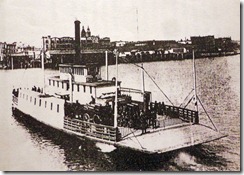 |
|
| Stark Street Ferry — Willamette River |
New Westminster agreed to pay the Willamette Iron Works for the plans. In July 1890 tenders were called for the building of the new steam ferry to replace the K de K. Captain Michael Terhune won the bid and work started on the vessel at the Brunette Shipyards. Reid and Currie were subcontractors for the fittings.
